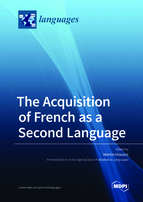The Acquisition of French as a Second Language
A special issue of Languages (ISSN 2226-471X).
Deadline for manuscript submissions: closed (1 November 2020) | Viewed by 41093
Special Issue Editor
Interests: second language acquisition; additional language education; linguistic development; (socio) linguistic variation; motivation; advanced language learner; international student mobility; study abroad
Special Issues, Collections and Topics in MDPI journals
Special Issue Information
Dear Colleagues,
Article submissions are invited for a Special Issue of Languages on the theme of ‘The acquisition of French: First and Second Language Perspectives’. The Special Issue will address key areas in linguistic development, input issues, and the role of individual factors using diverse approaches and methods in the investigation of French L1/L2 acquisition. In the case of linguistic development, articles may focus on pronunciation, fluency, lexis, grammar, discourse, sociolinguistic competence and pragmatics, and target speaking, listening, reading, and writing. Additionally, studies that comparatively explore the L1–L2 and L2–L3 multilingual interface are also welcome. Articles may present empirical studies on learners at all stages of acquisition and in different learning contexts, such as naturalistic, instructed, immersion, and study abroad contexts. In the case of French L2 studies, research may focus on learners of a variety of source languages. Discussion articles are also welcome.
The Special Issue will offer a timely update on the acquisition of L1/L2 French in the context of contemporary theoretical issues, questions, and debates within L1/L2 acquisition. The Special Issue thus complements and builds on previous volumes on the acquisition of French such as Dewaele (2005), Labeau and Myles (2011), Lindqvist and Bardel (2012), Myles and Towell (2004), and Prévost (2009). Articles should be approximately 8000 words in length, while discussion articles may be shorter and follow the guidelines for presentation that are available on the journal website.
The tentative completion schedule is as follows:
-Abstract submission deadline: 15 April 2020
-Notification of abstract acceptance: 1 May 2020
-Full manuscript deadline: 1 November 2020
References
Dewaele, J-M. (2005) Focus on French as a foreign language. Clevedon: Multilingual Matters.
Labeau, E. and Myles, F. (2011) The advanced learner variety. The case of French. Frankfurt: Peter Lang.
Lindqvist, C. and Bardel, C. (2012) The acquisition of French as a second language. Amsterdam: Benjamins.
Myles, F. and Towell, R. (2004) The acquisition of French as a second language. Special issue of Journal of French Language Studies 14,3.
Prévost, P. (2009) The acquisition of French: The development of inflectional morphology and syntax, in L1 acquisition, bilingualism, and L2 acquisition. Amsterdam: Benjamins.
Dr. Martin Howard
Guest Editor
Manuscript Submission Information
Manuscripts should be submitted online at www.mdpi.com by registering and logging in to this website. Once you are registered, click here to go to the submission form. Manuscripts can be submitted until the deadline. All submissions that pass pre-check are peer-reviewed. Accepted papers will be published continuously in the journal (as soon as accepted) and will be listed together on the special issue website. Research articles, review articles as well as short communications are invited. For planned papers, a title and short abstract (about 100 words) can be sent to the Editorial Office for announcement on this website.
Submitted manuscripts should not have been published previously, nor be under consideration for publication elsewhere (except conference proceedings papers). All manuscripts are thoroughly refereed through a double-blind peer-review process. A guide for authors and other relevant information for submission of manuscripts is available on the Instructions for Authors page. Languages is an international peer-reviewed open access monthly journal published by MDPI.
Please visit the Instructions for Authors page before submitting a manuscript. The Article Processing Charge (APC) for publication in this open access journal is 1400 CHF (Swiss Francs). Submitted papers should be well formatted and use good English. Authors may use MDPI's English editing service prior to publication or during author revisions.
Keywords
- French
- L2 acquisition
- L1 acquisition
- linguistic development
- input
- individual differences
- age factor
- pronunciation
- fluency
- lexis
- grammar
- discourse
- sociolinguistic competence
- pragmatics
- instruction
- immersion
- study abroad
- L1-L2 interface






